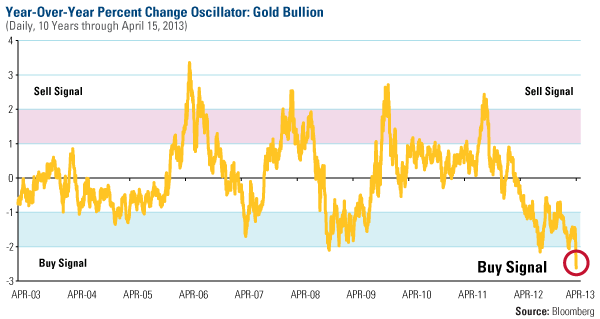Gold Market Radar (April 22, 2013)
For the week, spot gold closed at $1,403.75, down $79.25 per ounce, or 4.02 percent. Gold stocks, as measured by the NYSE Arca Gold Miners Index, fell 11.30 percent. The U.S. Trade-Weighted Dollar Index rose 0.56 percent for the week.
Strengths
- You were wrong if you thought the drop in gold prices reflected lower consumer demand. The fact is the U.S. Mint’s sales of gold coins soared this week following the price plunge. On Thursday, the Mint reported sales of 153,000 ounces of gold coins, the highest in nearly three years, twice as much as sold in March, and seven times the volume sold this same week last year.
- The price drop also provoked clamor in the love trade countries. In the Zaveri Bazaar in Mumbai, India’s largest bullion market, demand in recent days was the most this year according to the All India Gems & Jewellery Trade Federation. Further east, Hong Kong and Macau gold merchants saw a 150 percent increase in sales last weekend, while consumer traffic rose 40 percent from a week earlier.
- The buying this week was not only reserved to consumers in Asia. John Paulson reaffirmed his belief in gold and reiterated his commitment to his gold holdings. From Manila, Christopher Wood noted on his latest Greed & Fear report that he is personally taking the opportunity to increase bullion holdings in his pension portfolio. He is reportedly adding another 5 percentage points to his physical gold holdings and suggests adding more if there is another dip.
Weaknesses
- The “tax” attack on gold companies continues. Following the Canaccord Genuity report criticizing the increase in bureaucracy and significant permitting delays mining companies have faced in Mexico since President Pena Nieto took office in December last year, the country’s lawmakers expeditiously approved a new 4 percent mining royalty tax on net profits. It is clear the proponents of the law have not been watching the news recently since they argue mining companies are highly profitable and have been reaping all the benefits for years. We believe the move will only serve to hurt Mexico’s hard-earned reputation as a friendly mining jurisdiction.
- Macquarie’s Equity Research continued the trend of stress testing gold producers’ balance sheets with ever lower gold price forecasts. The conclusion is that most companies that are currently engaged in the development of uber-large projects will likely be forced to defer capital expenditures or abandon projects altogether. Smaller caps without significant current production will likely bear the biggest burden as they likely have less flexibility to defer capital expenditures and some will unequivocally go out of business. However, Macquarie notes fully funded growth names such as Alamos Gold will continue to be profitable even in a sustained $1,200 per ounce gold environment.
- In 2004, gold ETFs held 0.5 million ounces. This number rose to a peak of 84.6 million ounces in December 2012. Since then, gold ETFs have liquidated 8.6 million ounces or roughly 10.2 percent of their holdings. The speculative short positions on Comex gold have receded from their February peak; however, they still stand just under 10 million ounces, levels not seen for nearly a decade. We believe it is important for investors to understand the volume of speculative flows in the gold market that create unwarranted volatility and, at times, hide the fact that gold fundamentals remain unchanged.
Opportunities
- Following Monday’s price action on gold our team analyzed the recent moves from a statistical perspective. Year-over-year going back 10 years, gold’s move is a -2.6 standard deviation (sigma) change. This price action puts the price of gold in uncharted territory because out of a total of 2,610 trading days, there has only been one such occurrence and that was precisely on Monday. The likelihood of such an event happening is 0.04 percent of the time (1/2610 = 0.04 percent). On a 60-day basis going back 10 years, gold is down 3.2 sigma. By applying the concept of mean reversion, it is quite likely that gold will rebound strongly from these levels.
- Further to our analysis, Nick Pocrnic of Stifel Nicolaus reported this week on the unprecedented price action of gold as measured by the SPDR Gold Shares ETF (GLD). The two-day (Friday and Monday) move in GLD was -16.65 at the time of his writing, which can be converted to over 8 standard deviations. He strongly believes we will not see a similar trading action in our lifetime, based on statistical analysis. He states this fall will go down in history as an aberration of truly historic proportions. As Gartman noted to put it into perspective: the sun is expected to burn out first before we see a move like that again.
- The news that Cyprus would sell a part of its gold reserves as part of the bail-out process made many rounds around the world. What didn’t make as many rounds in the news were the comments by the South Korean and South African central banks stating gold is a key part of their international reserves they are not willing to forgo. The Sri Lankan central bank went further and declared it was looking at the price action as an opportunity to increase its bullion reserves. We are of the opinion that Sri Lanka is only one out of a large number of nations looking at buying the dip to add gold reserves.
Threats
- The fall in bullion prices over the last few days can only be described as panic selling according to Sprott Group. Money managers and veteran traders know that when panic sets in, investing logic drops by the wayside and money begins to flow one direction only. This selling in turn acts to drive prices lower, which in turn forces those holders on margin to liquidate their positions. This process leads to even more selling as the pain of holding levered "under water" positions becomes too great, causing traders to liquidate their positions. Despite the risk that this type of selling represents to the gold industry, unlevered long term fundamental investors should not be directly affected as the panic selling cannot last forever. We believe once the panic selling is over, gold will begin a slow but strong upward trend to levels that reflect its fundamental value.
- Never has it been more clear that “paper” gold and physical gold are two different assets, and rarely do we get the opportunity of demonstrating that physical gold is effectively a currency, a relatively safe currency, while paper gold is a financial asset subject to market speculation. As Jim Rickards noted on Friday, if you were a holder of physical gold on Monday, you saw the quotes falling on your screen, but when you turned around to your vault you held the same number of ounces of gold. If you owned the GLD ETF over the same trading day you would have seen your dollar trading account decreasing every minute. We are of the opinion investors are being misled into purchasing paper gold such as futures or ETFs thinking they offer the same inflation protection as bullion purchases; these behave like financial assets and pose a threat to physical gold’s claim as a safe heaven.
- Given the increasing talk of paper gold and physical gold, we would like to revisit last week’s news by ABN AMRO bank. As we reported, the largest Dutch bank sent a letter to customers stating the bank would be unable to deliver physical gold on customers’ gold claims and would instead offer a paper gold claim to its customers. The bank made the paper gold claim appear as valuable as the physical gold claim without telling investors the new “product” was subject to the bank’s credit risk, as well as to market speculation. We continue to believe this in just one of the many deliberate actions to make paper and physical gold appear like one and the same, something that mistakenly puts physical gold’s safe heaven credibility in doubt.













